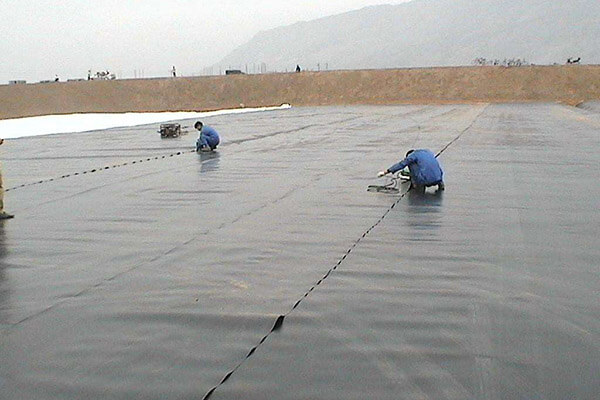The durability of the geomembrane is better under the protection of the protective layer
Option 1, a medium-low head earth-rock dam on a homogeneous or double-layer foundation, with a thick permeable layer and no strong permeable interlayer, has advantages in economy and construction period compared with the general vertical anti-seepage measures. However, due to the laying of inclined clay walls, the reservoir needs to be emptied and silt dredged, construction costs will increase accordingly. In areas where clay is widely distributed, clay can be obtained locally. However, this project is located in a mountainous area and the per capita arable land area is very small. The use of cohesive soil as an anti-seepage material often causes disputes at the cost of damaging the cultivated land. The construction unit may pay more manpower and financial resources for this. In addition, the anti-seepage effect of the clay inclined wall has an important relationship with the compaction effect of the clay in the construction, the construction reliability is low, and the shrinkage cracks are prone to occur when the water level changes. In addition, the eel in the water easily destroys its structure and reduces its durability.

Option 2, the dam body adopts composite geomembrane for seepage prevention, a concrete tooth wall is added on the upstream surface, and curtain grouting is used for the dam foundation below the tooth wall to form a complete anti-seepage system. The fourth option is to lay an anti-seepage geomembrane on the dam body and add concrete tooth walls on the upstream bank slope for seepage prevention treatment. Filling grouting is used to prevent leakage between the intercepting tooth wall and the foundation curtain, forming a complete anti-seepage system. Both schemes use composite geomembrane to prevent seepage on the dam surface, which has the advantages of fast construction speed, low cost, lightweight, economical cost of anti-seepage materials per unit area, convenient transportation, and convenient construction. The requirements for the surrounding environment are not high; the dam has good deformation adaptability, external construction, simple operation, and high construction reliability; under the protection of the protective layer, the durability of the geomembrane is better. The geomembrane is basically impermeable, and its impermeability is better than clay. However, this project is already built and the reservoir has been in operation for 52 years. According to sediment calculation, the elevation of sediment in front of the dam is 1.031.42 m, the elevation of the dam’s base surface is 1.024.30 m, and the height of sediment in front of the dam is 7.12 m. It is difficult for the tooth wall to be placed on the base surface of the dam foot. Option 4 is designed to arrange the tooth wall above the silt height of the upstream dam surface and consider the impact of construction floods. Compared with the second plan, it avoids dredging, lays quickly and conveniently, the construction technology is simple, and the actual operability is superior.
The better anti-seepage effect of Option 3 is theoretical data. The dam body of this project has been expanded, and there is leakage in the grouting section in the contact section of the new and old dam bodies, and the leakage problem has not been solved after grouting treatment. Therefore, the anti-seepage effect is greatly affected by the construction. The dam body and foundation are grouted, so the cost is relatively high.
